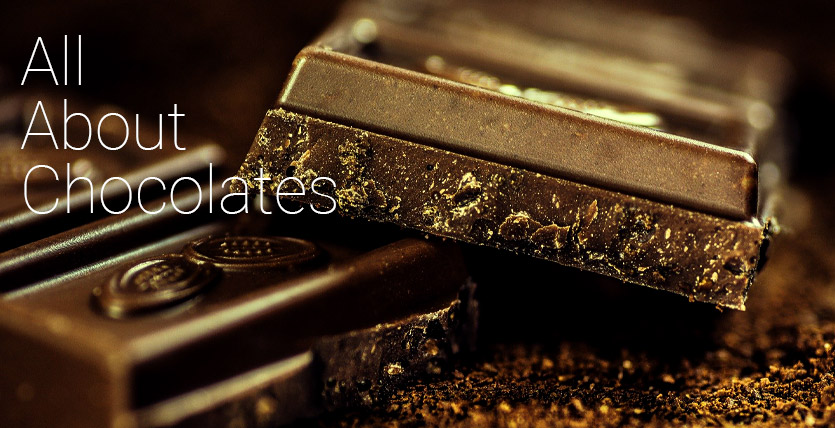All About Chocolate And Its Benefits

The core purpose of this write-up is to explore all about chocolate. We will dig into the history of this tasty delicacy, and understand some health benefits, facts, and more.
Eating chocolate has always been associated with weight gain, high blood pressure, acne, diabetes, etc. After eating a small piece, a feeling of guilt inculcates within us.
Questions that can ripple in our minds are – What will be the consequences of eating this delicious piece of divinity? Consuming chocolate satisfies our taste buds but will it do any good to our bodies? What if it does more harm than good?
A sigh of relief for chocolate lovers
This sweet dainty is not just loaded with calories but health benefits too. Cocoa is the main component of it. It contains biologically active phenolic compounds that raise the range of health advantages. Eating this mouth-watering goody does more good than harm.
A word of caution
Too much is not good. Do not eat this sweet treat with guilt, but do not overeat. It is packed, with calories eating more will undoubtedly harm than good. A small piece or two should be enough.
Some facts
- It is made from the seeds of the tropical cacao tree.
- Research suggests it may have health benefits.
- Cravings for it may be a symptom of addiction.
- It contains the same “happy” chemicals found in some recreational drugs. It makes you smile.
- This well-loved food if eaten in moderation is a good source of nutrition.
- It is loaded with oodles of calories. So weight watchers keep a watch on the portion.
- For some individuals, it can activate migraines.
- Chocolate milk is considered to be a perfect carb-protein combo. It is an ideal post-workout drink.
- People who eat it are less likely to die from a stroke.
- Enhances good gut bacteria.
- Increases workout power hence increasing athletic performance.
Chocolate history
The Aztecs discovered that by crushing the beans (of the seeds of the Theobroma cacao tree), into a paste and adding spices, they could make a refreshing and nourishing drink.
This drink would have been very bitter, unlike our chocolate drinks today. 16th-century European explorers brought the drink back from their travels, added sweeter flavorings, and soon it was popular as an expensive luxury.
The first chocolate bars
In the 1800s, solid chocolate became popular with the invention of molding processes. Mechanical grinders crushed cocoa beans to a fine powder that is then heated and poured into molds, forming shapes as it cooked.
Dutchmen Conrad Van Houlton perfected the extraction of cocoa butter from cocoa beans in 1825. The beans are crushed to a paste, which is subjected to very high pressure, forming chocolate liquor and cocoa butter. The extracted butter is smoothed and treated to remove any odors.
In the 1880s Rudolph Lindt of Switzerland started adding extra cocoa butter to chocolate manufacturing, to make it smoother and glossier. Cocoa butter melts at around 97degree F, which is human body temp. That’s why it melts in the mouth.
Milk chocolate
In 1875, Swiss Daniel Peter perfected the manufacture of milk chocolate, which is sweeter and smoother than dark chocolate. Nestlé’s invented condensed milk which was easy to mix with cocoa paste, unlike liquid milk.
Cadbury’s Dairy Milk, first developed in 1905, is the UK’s most popular chocolate bar. Milk chocolate is now the world’s best-selling variety.
Craving and addiction
All modern commercial chocolate products contain substantial amounts of sugar, a fact that may partly explain chocolate’s supposed addictive properties.
Why does chocolate make us feel good?
Several more obscure ingredients seem to act by affecting the brain’s neurotransmitter network.
The neurotransmitter is the chemical messenger of the brain. They work by transporting electrical signals between nerve cells. These signals cause changes in the sensations and emotions that we experience.
Love drug?
It contains a natural love drug. Tryptophan is a chemical that the brain uses to make a neurotransmitter called serotonin High level of serotonin can produce feelings of elation, even ecstasy – hence the name of the designer drug that also works by increasing serotonin levels.
Chocolate toothpaste
Chocolate could help to prevent tooth decay, according to scientists at Japan Osaka University. The husks of the cocoa beans from which it is made contain an antibacterial agent that fights plaque. These husks are usually discarded in their production but in the future, they could be added back into chocolate to make it dental-friendly.
Hearty findings
Californian Scientist Professor Carl keen and his team have suggested that chocolate might help fight heart disease. They say that it contains chemicals called flavonoids, which thin the blood, helping to prevent clotting. Scientists have already suggested that red wine act’s in this way.
Good news and bad news
Researchers at Harvard University have carried out experiments that suggest that if you eat chocolate three times a month you will live almost a year longer than those who forgo such sweet temptation.
But it’s not all good news – Harvard research also suggests that people who eat too much chocolate have a lower life expectancy. Chocolate’s high-fat content means that excessive indulgence can contribute to obesity leading to an increased risk of heart disease.
How much chocolate should be consumed?
The calculation of the health-boosting benefits is based on the percentage of cocoa and sugar in it. The portion of cocoa should be at least 70%. Less sugar and more cocoa add more benefits.
Milk vs. dark chocolate
Dark chocolate has high cocoa content. It has got many health benefits and is packed with minerals and a good portion of soluble fiber, selenium, copper, magnesium, iron, manganese, phosphorus, zinc, and potassium. It also contains heart-healthy fat. These nutrients come with gallops of calories.
Milk or light chocolate contains protein, milk, and calcium. For any category of chocolate, consumption in moderation is the key to gaining benefits from it.
Some Health benefits
The antioxidant potential of chocolate makes it highly advantageous for health in many ways.
Enhances cardiovascular health
This high fat and sugar-loaded treat holds plant sterols (PS) and cocoa flavanols (CF) and improves heart health.
Manage weight
Though it is associated with weight gain, consumption of dark chocolate help to manage weight. It is vital to check the portion size and the percentage of cocoa in it. A bar containing more cocoa helps manage weight.
Cocoa flavonoids improve memory
Cocoa flavonoids help improves memory and keeps the brain healthy. Two cups of chocolate drink daily can reduce memory decline in aged people.
Mood lifter
Serotonin and dopamine are feel-good hormones. Chocolate helps control them and hence uplifts your mood. Can control blood clots.
Polyphenols present in it can raise the flow of the blood. The increase in blood flow widens the blood vessels and helps prevents blood clots.
Reduce inflammation
Chocolate can keep you healthy by providing an anti-inflammatory effect on the body. Moreover, manages the bacterial composition and hence helps in ameliorating ailments.
Lowers blood pressure
Besides the outcomes of lowering blood pressure are usually mild it does improve blood flow.
Ending
To attain the health benefits of chocolate check the percentage of cocoa in it. It is always better to consume sugar-free hot cocoa/chocolate.
Dark chocolates contain more cocoa and have less sugar. They provide significant health advantages if consumed a square or two post dinners. Relish this sweet piece of delicacy delicately.
Disclaimer: This write-up contains content for general information only. There is no alternative to an opinion from a skilled expert.
Keep posting your inputs, remarks, and opinion in the comments section.























